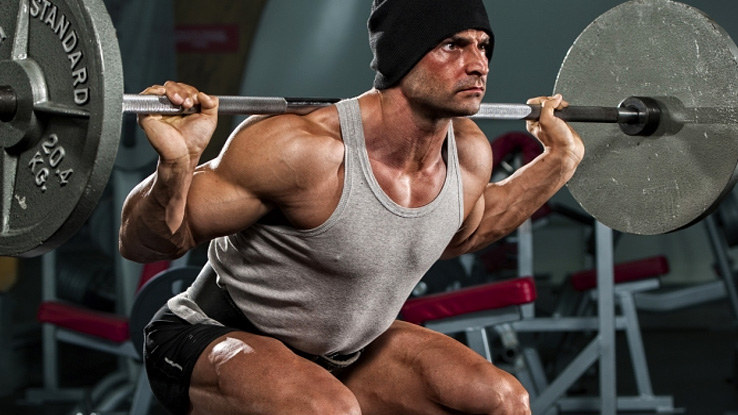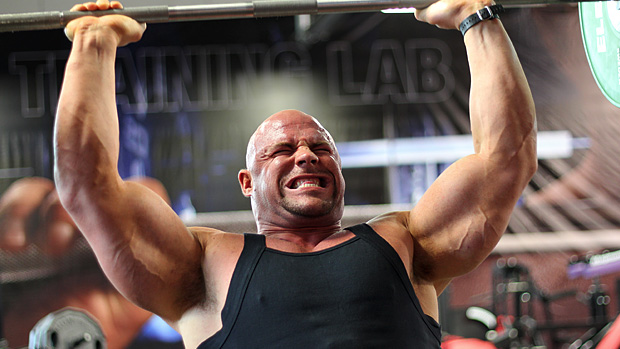If you're barely able to lift your arms above your head without cringing or compensating in some manner, don't ask me or any other competent coach to build overhead pressing into your program.
I don't include overhead pressing in many of the programs I write because, well, it's just not going to be pretty. More to the point, it's just not right for every athlete.
Is it right for you? Let's find out.
Simple Overhead Pressing Screens
Overhead pressing requires a litany of intricate "checks and balances" between our joints to be performed correctly. It isn't as simple as grabbing a bar and hoisting it over our head. Overhead pressing requires some of the following:
- Proper pelvic positioning or ample lumbo-pelvic-hip control.
- Ample core stiffness and stability.
- Proper scapular positioning and stability (i.e., limited scapular anterior tilt, which
will be dictated by your level of thoracic kyphosis.) - Sufficient glenohumeral mobility/centrality, which can be woefully affected by shoulder girdle positioning. Those with overly depressed shoulders will have trouble here.
- Limited forward head posture versus packed neck. The latter is ideal.
While the screens below aren't meant to be an all-encompassing approach to ascertaining whether you should do overhead pressing, they do serve as a nice primer to whether it's a good fit for most people.
Supine Shoulder Flexion
Lying on a table with your arms at your sides, elbows extended, knees bent, and low back flat on the table, simply raise both arms overhead and bring them down towards the table.
In this screen we're assessing lat length, which undoubtedly plays a key role in your ability to get your arms up over your head.

Shortness: Inability to get arms to table level.
Standing Shoulder Flexion
A more dynamic way to assess lat length is to assess in the standing position.
Standing upright with your hands at your sides and with your palms facing one another, simply lift your arms up over your head.
Those with short or stiff lats (or kyphotic posture) will have a hard time raising their arms over their head without compensating in some fashion, whether by protruding their head forward or by picking up the slack with excessive lumbar extension.

Right: Proper shoulder flexion.
Unfortunately, many lifters won't make the cut, which makes shifting towards the appropriate regressions all the more important in terms of long-term shoulder health.
This doesn't mean we need to get all "functional," though, and start performing a bunch of lame exercises like BOSU-ball apple juggling while hopping on one leg.
Instead, it's important to seek and maintain a strong training effect with dedicated strength training while simultaneously putting on the brakes in the form of some dedicated corrective work.
Hammer Those Upper Traps!
While anterior/posterior imbalances – namely, pushing vs. pulling volume and strength (most guys are very pec dominant) – are important to address, not many people give any credence to inferior/superior imbalances.
Translated into English, we also have to be aware of the interplay between upward and downward rotation. More and more, we're seeing clients walk in with overly depressed or downwardly sloped shoulders.

As an example, I've shared this picture before in the past:
That's me with some seriously depressed shoulders. This can spell trouble for those whose livelihood revolves around the ability to get their arms over their head (baseball players) as the downward rotators of the scapulae are kicking into overdrive and really messing with the congruency and synergy between the scapulae, humeral head, glenoid fossa, and acromion process.
And this doesn't just pertain to overhead athletes, either.
We're seeing this quite a bit in the general population as well, and as fitness professionals we've been preaching "shoulder blades together and down" for years.
In this case, some dedicated upper trap work would be advisable to encourage more scapular upward rotation, which in turn will help to elevate the entire shoulder girdle.
And no, for the record, I'm not referring to barbell shrugs!
While shrugs have their place, overall these wouldn't be useful because there's no real scapular upward rotation involved. All we'd be doing is encouraging more shoulder depression.
Furthermore, whether the culprit is poor t-spine mobility, short/stiff lats, or a combination of other things, there are a bevy of compensation patterns that can arise when one has trouble getting their arms overhead.
When this happens, it's advantageous to include some basic corrective exercises to help engrain new motor patterns and help move the process along.
As such, we want to place a premium on drills that target the upper traps (while also involving upward rotation) as well as addressing lat length.
Some favorites include:
1 Forearm Wall Slides with Overhead Shrug
Facing a wall with a staggered stance (to limit lumbar extension), place your forearms flush against a wall, and then "glide" them upwards towards the ceiling.
Here, we like to cue a slight shrugging pattern once the elbows reach shoulder height.
Make sure you lock the rib cage down and to fully exhale once you reach the top position.
2 Back-to-Wall Shoulder Flexion with Overhead Shrug
This is a fantastic drill to address lat length, which tends to be an issue for those with overly depressed shoulders.
What you'll see is someone going into excessive lumbar extension to compensate for lack of shoulder flexion (as demonstrated in the video above).
The idea here is to posteriorly tilt the pelvis so that the lumbar spine is flat against the wall. You shouldn't be able to place your hand between the wall and your back.
With the back of your head, shoulders, and lumbar spine flush against the wall, slowly raise your arms up above your head making sure to maintain all points of contact throughout.
Midway through – once your hands are in line with your shoulders – you'll want to lightly shrug to aid upper trap activation and hence upward rotation.
The Landmine Press
Time to get to the nitty-gritty and showcase some user-friendly overhead pressing variations.
On top of the list, and easily my go-to exercise is the landmine press.
And while it's a fantastic way to regress things yet still train the shoulders and upper body in a joint-friendly manner, the landmine press offers numerous full-body benefits as well:
- Because the exercise forces you to resist extension, the landmine press is a fantastic anterior core exercise. Moreover, since it's an offset (asymmetrical) loaded exercise, there's a massive anti-rotation or rotary component as well.
- Likewise, the asymmetrical nature of the landmine press trains thoracic mobility and dynamic stability of the scapulae, which isn't so much the case with push-up variations or bilateral upper body movements.
- And, depending on which variation you implement, you can make landmine presses a full-body movement outright, which has its benefits from a muscle building and metabolic training standpoint.
Half-Kneeling Landmine Press
I view the half-kneeling variation as the first progression because it takes the lumbar spine out of the equation, making it harder to compensate.
What's more, with this variation you also get a nice static hip flexor stretch on the kneeling leg, which is only amplified when you cue yourself to squeeze the same-side glute.
Some other basic cues to consider:
- Brace your core to resist extension and rotation.
- Press straight up, not across your body.
- For those who need a little more upper trap activation, add a slight shrug or protraction at the top of each rep.
- Try not to allow the elbow to go past the midline of the body as you lower the bar back to the starting position. Doing so will prevent excessive scapular anterior tilt and forward migration of the glenohumeral joint.
- For some additional time under tension, add a 5-10 second isometric hold at the bottom of each rep.
Standing Split-Stance Landmine Press
Progress the exercise by moving into a standing position, albeit with a split stance in order to make it harder to compensate with excessive lumbar extension.
From there, we can revert to a "squared" stance, being cognizant of proper pelvic positioning:
Once those are mastered we can then start to have a little fun and incorporate more athletic variations:
Alternating Landmine Press
Explosive Landmine Press with Twist
Reverse Lunge to Landmine Press
And for those who really want to hate life:
Deep Squat Landmine Press
Final Analysis
Overhead pressing is awesome, but most people suck at it and end up hurting themselves in the process.
You might be surprised how much progress you can make in the long-term by addressing postural deficits and making some slight modifications.
Remember, long term training success isn't a product of doing what's popular or cool – it's a product of intelligent exercise prescription based upon your specific
needs and limitations.





